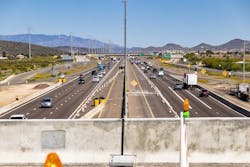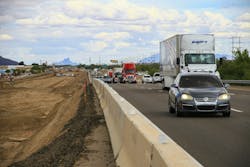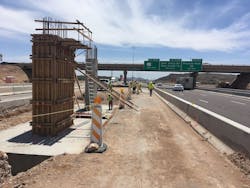Safer work zones through technology
We all want safer roads. A word that has frequently been used lately in the transportation safety industry is “zero.”
The Federal Highway Administration has put it very succinctly, “The primary safety goal of the Federal Highway Administration (FHWA) is to reduce transportation-related fatalities and serious injuries across the transportation system, and for this reason it fully supports the vision of zero deaths.” Who can’t get behind that? Zero fatalities should be our overall, long-range goal. But, a quick Google search will show that in 2018, there were more than 36,000 estimated traffic-related deaths in our nation; a very sobering reality check when one considers this safety challenge.
So what can we do? For me, my passion is in increasing the safety performance of work zones. As an engineer with the Arizona Department of Transportation (ADOT) for more than 17 years—the first 12 in construction—I have unfortunately seen firsthand the devastation of crashes in work zones. So this is very personal and close to my heart.
I like to remind myself how many cartoons and clips I have seen from the 1950s and 1960s depicting how we all should have flying cars and robots performing our mundane household tasks by now. While those things have not come to pass, we are able to ask how we can use all the wonderful technology we currently possess to make work zones safer.
The “smart work zone” is a concept that takes advantage of the technology we have. It relies on real-time data and provides ways to process that data to help us adjust the conditions of traffic. The key concept to having an effective smart work zone is timely, reliable data.
It has been said that what gets measured gets done. The most important regulation on work zone safety and mobility is Title 23, Part 630, Subpart J of the Code of Federal Regulations, or as most of us in the industry simply call it, “The Rule.” The regulation’s overall goal is to reduce crashes and congestion due to work zones. One of the most important aspects of “The Rule” is the need for data. Unfortunately, I learned very quickly that data can mean many different things.
As I followed Alice into the Wonderland that is data collection, I learned many things including the fact that work zone data collection has been going on for a long time. I learned what is currently being done to promote work zone safety and more importantly what changes have come about in recent years. I also learned what limitations we currently face.
So, what data do we currently have available? My agency currently subscribes to real-time traffic data that in turn provides mobility data. This is a great start since mobility relates to safety. If mobility is impacted or decreased, crashes increase. Therefore, improving mobility will improve safety, and as any good safety officer will tell you, using engineering controls to eliminate safety concerns is the best control strategy. Traffic operations are a key component of increasing safety in our work zones.
Crash records are one of the most important sources of good data. The downside is this data cannot always be provided in a timely manner. Days and even months can pass before all the data can be collected, entered, and analyzed.
I want work zone safety data in real time. I want to be able to make changes with indicating factors before a crash or fatality happens. I want to know about a problem before even the most seasoned work zone expert can decide if there are changes that could be made to improve the set up.
Smart work zones are a great step, even a giant leap, in that direction. With traffic sensors to measure the speed and density of traffic, portable message boards to provide information to drivers, and a computer system to tie all of the data in and relay the appropriate message to motorists, smart work zones offer real-time data, portability, and a level of automation.
The two primary types of smart work zone systems are queue management and travel time systems. A queue management setup could include a queue warning system which alerts drivers if traffic is building and to slow down; a dynamic lane merge which tells drivers approaching a work zone with a lane closure to merge early or right before the lane closure depending on traffic speed; or a hybrid of both. ADOT is using these forms of queue management on different projects with promising results.
Travel time systems can be utilized by providing motorists with travel times via two routes through the work zone and using a detour, or by simply providing the expected delay while traveling through the work zone. There are also smart truck entering/exiting systems, which detect slow-moving construction vehicles and send advanced warning to motorists so they have time to switch lanes to allow for the construction vehicle to merge safely. A more recent, but popular category in smart work zones is using variable speed limit signs, which will alter the speed limit depending on traffic volume and speed. This system shows great promise to increase speed compliance within work zones.
And even with all of the concepts of smart work zones being implemented for testing now, the future holds more promise for using smart devices and collecting data to further improve the safety of work zones.
There are endless variations of existing devices becoming “smart.” The data they generate can be used to work in conjunction with a smart work zone system that increases the overall picture of what is happening in the work zone. Some current devices being used are smart arrow boards, smart traffic cones equipped with GPS location sensors, smart signs, smart portable changeable message boards, and even smart temporary and portable transverse rumble strips. Eventually, every single device in the work zone will be “smart,” and I expect the name will be dropped completely from use, only to remain as something for future generations to chuckle about.
Individually, each of these devices can be useful. But when used in combination with each other and other systems, they can provide better data and opportunities to make better safety connections.
The data these devices can provide is being standardized even now through a federally led Work Zone Data Initiative. In the future, we could have a situation where smart work zones and vehicles with smart technology talk to each other, exchanging data and allowing for smoother merging in work zones, providing alternate routes around the work zone that are quicker and other possibilities.
Even with a future that will likely be something vastly different from what was depicted in those mid-20th century cartoons, work zones will always be with us. Improving safety for not only drivers, but also for the brave men and women working in our work zones, is paramount. Technology and smart work zones give us a leg up in the right direction and provide us with something to build on, as we strive for that figure of “zero deaths” as part of our future.



